More on this book
Community
Kindle Notes & Highlights
Read between
August 13 - December 8, 2018
In Jung's view, certain symbols, aspirations, and behavioral modes (archetypes) are biologically hard wired into mankind.
they explain events when the secular world (the domain of kings) is being redefined beyond prior recognition—in
A society will not elevate an event (or story) into myth unless it illustrates enduring human tendencies. This ordering reflects a latent understanding of the shadow suppressed within each archetype.
Archetypes do not create archetypes like themselves; instead, they create the shadows of archetypes like themselves.
recurring progression of political regimes—from kingship to aristocracy to democracy to anarchy —from which a new kingship would emerge.
two discoveries: first, that history moves through stages (circular or linear) of social change; and second, that parent-child tensions provide the motive force pushing society from one stage to the next.
According to Ferrari, a revolutionary generation launches a new idea, a reactionary generation battles against that idea, a harmonizing generation uses that idea to establish community and build political institutions, and a preparatory generation subtly undermines that harmony, after which the cycle repeats.
German historian Eduard Wechssler to write about generations as a succession of “struggles over world views.”
The young soldiers of one great war later refrain, as elder leaders, from declaring another. Those who have no memory at all of the first later become the declarers of the next great war.
four-part cycle: The first generation creates and initiates, the second fabricates a conformist personality, the third reflects and theorizes, and the fourth stylistically challenges forms and customs.
The first generation constructs institutions, the second perfects those institutions while becoming aware of their moral failings (an attitude he calls hypocritical), the third propounds new ideals, and the fourth tests those ideals while becoming aware of their practical failings
cyclical alternation between the setting of norms and the attainment of goals.
four-part saecular dynamic is a sequence that runs from a constructive to an adaptive to a normative to a competitive generation coming of age.
takes “four whole and consecutive generations to traverse the complete problem solving sequence.”
It never matters as much where a generation is as where it is going.
every organism, through its development, both stays the same and yet transforms into its opposite.
the Silent, who were once chided for their “lonely crowd” conformism but who now are enjoying a lifestyle of exuberant individualism full of “choices” and options.
We like to think that we are total masters of our destiny, exempt from all cycles, able to choose whatever we desire whenever we desire it.
pursuing refinement and expertise more than power.
In nature, the season that is about to come is always the season farthest removed from memory.
bookge
The Invasion of the Body Snatchers satirized citizens so robotic that nobody noticed when they were taken over by aliens.
The High mind-set included many elements that today's Americans loathe—from racism and sexism to a stifling group-think and a philistine culture.
Beneath the outward contentment, people ignore what are later deemed to be flagrant injustices.
the “unhappy fate … to be young in an era when age was respected, and old in a time when youth took the palm.”
“mixture of relatively good mothering” and “distant… repressive fathers.”
In the Lost view, Communism was less an economic paradigm than a rival bully to be thwarted mano a mano, with “brinksman-ship” if necessary.
High-era young man who didn't want to “settle down” in marriage “laid himself open to the charge of immaturity, if not latent or blatant homosexuality. Or he was just plain selfish. Or was frightened of responsibility.”
Premonitions of guilt began seeping into the Silent mind-set, a dread that horrible social crimes were being committed and hushed up, all for the sake of social discipline.
Alistair Cooke to warn that a “healthy rage against the pretensions and abuses of authority” could lead to “an amused distrust for any system or authority at all.”
Corporations crushed the individual, police oppressed the poor, academe smothered creativity, and parents deformed the child's psyche.
During the tax-cut fever of the late 1970s and the rise of Ronald Reagan in 1980, conservatives at last gave up on the Establishment.
Picture Governor De Witt Clinton opening the stately Erie Canal next to the swooning young workers creating an evangelical Burned-Over District along its route.
G.I. industrialists constantly heard themselves accused of moral outrages against nature, women, minorities, the poor, and the deepest needs of the human soul.
less concerned with real-world outcomes than with the fairness of the process by which competing ideals are reconciled.
Under Silent command, even computers have started talking to each other: Space shuttles began carrying three, whose disagreements were resolved by two-to-one votes.
the world is too complicated to permit anything other than gradual change.
rasilent.
Boomers came to call themselves conservatives than liberals, a difference that said less about their politics than about their self-perception as totally rooted and self-secure, beyond the reach of opinion or edict or even sociability.
Laid off professionals often mask underemployment by becoming self-employed contractors or consultants.
twrf-conservatives.
wermeasure
undermeasurQ
quality of American life has declined by 40 percent since the mid-1970s.
the culture is harnessed as propaganda for the purpose of overtly reinforcing good conduct.
a new dynamic of threat and response takes hold. Instead of downplaying problems, leaders start exaggerating them. Instead of deferring solutions, they accelerate them.
A new resolve about urgent public goals crowds out qualms about questionable public means.
mediocre leaders can gain immense popular following; bad policies can be made to work (or, at least, be perceived as working);


